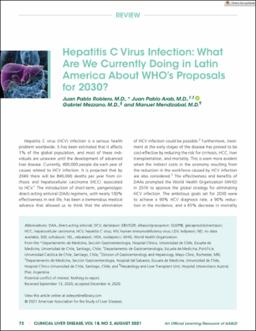| dc.contributor.author | Mendizabal, Manuel. | |
| dc.contributor.author | Roblero, Juan Pablo. | |
| dc.contributor.author | Arab, Juan. | |
| dc.contributor.author | Et al. | |
| dc.date.accessioned | 2023-08-25T14:41:00Z | |
| dc.date.available | 2023-08-25T14:41:00Z | |
| dc.date.issued | 2021-09 | |
| dc.identifier.citation | Clin Liver Dis (Hoboken) . 2021 Sep 19;18(2):72-75. | es |
| dc.identifier.uri | https://riu.austral.edu.ar/handle/123456789/2279 | |
| dc.description | Disponible en: https://aasldpubs.onlinelibrary.wiley.com/doi/10.1002/cld.1084 | es |
| dc.description.abstract | Hepatitis C virus (HCV) infection is a serious health problem worldwide. It has been estimated that it affects 1% of the global population, and most of these indi-viduals are unaware until the development of advanced liver disease. Currently, 400,000 people die each year of causes related to HCV infection. It is projected that by 2040 there will be 840,000 deaths per year from cir-rhosis and hepatocellular carcinoma (HCC) associated to HCV.1 The introduction of short- term, pangenotypic direct- acting antiviral (DAA) regimens, with nearly 100% effectiveness in real life, has been a tremendous medical advance that allowed us to think that the elimination | es |
| dc.language.iso | en | es |
| dc.publisher | American Association for the Study of Liver Diseases | es |
| dc.rights | Attribution-NonCommercial-NoDerivatives 4.0 Internacional | * |
| dc.rights.uri | http://creativecommons.org/licenses/by-nc-nd/4.0/ | * |
| dc.subject | Hepatitis C virus. | es |
| dc.subject | Latin America. | es |
| dc.subject | OMS. | es |
| dc.title | Hepatitis C Virus Infection: What Are We Currently Doing in Latin America About WHO's Proposals for 2030? | es |
| dc.type | Article | es |


